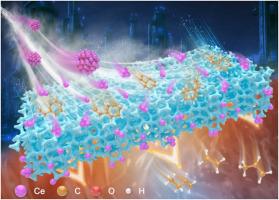纳米ceo2油分散体与ZSM-5协同原位协同催化:增强轻烯烃催化裂化
IF 4.7
3区 材料科学
Q1 CHEMISTRY, APPLIED
引用次数: 0
摘要
利用浸渍法对ZSM-5进行金属改性已被广泛研究并应用于工业催化,但由于Brønsted和Lewis酸位点的交叉影响,对其结构-性能关系的基本理解仍然具有挑战性。本文采用表面改性的油分散纳米ceo2,在催化裂化反应中原位强化Brønsted酸,观察了单原子Ce与ZSM-5的结合。研究了材料的形态演变和酸性质调整的定量描述,以连接Ce沉积分析和活性促进机制探索。结合反应动力学研究发现,该策略显著促进了质子化反应(速率限制步骤)中碳离子的生成,且Ce负荷较低,在不受Lewis酸变化影响的情况下,使乙基环己烷催化裂化的表观活化能降低41.1%,为开发先进的轻烯烃分子筛改性模式奠定了基础。分子模拟揭示了多价单原子Ce如何调节aloo - h的键强度,增强沸石的供质子能力。本文章由计算机程序翻译,如有差异,请以英文原文为准。

In situ synergistic catalysis by Nano-CeO2 oil dispersoid concerted with ZSM-5: Enhanced catalytic cracking for light olefins
The metal modification of ZSM-5 by impregnation method has been widely researched and applied in industrial catalysis, but fundamental understanding of their structure-property relationships were still remained challenging, largely due to the cross influence from Brønsted and Lewis acid sites. Here, using the oil dispersed nano-CeO2 with surface modified in reactant hydrocarbon, we propose a method to strengthen the Brønsted acid in situ during catalytic cracking reaction, wherein the monoatomic Ce incorporated with ZSM-5 was observed. The material morphological evolvement and quantitative description of acid properties tuning were investigated to bridge the Ce deposition analytics and the mechanism exploration for activity promotion. Combining with the reaction kinetics study, this strategy was found to significantly promote the carbonium ion generation step in protonation (rate limit step) with much less load of Ce, lowered the apparent activation energy of ethylcyclohexane catalytic cracking by 41.1 % without the influence from Lewis acid variation, and foregrounded the development of advanced zeolite modification mode for light olefins production. The molecular simulation revealed the insights of how polyvalent monoatomic Ce regulated the bond strength of AlO-H, and enhanced the proton donating ability of zeolite.
求助全文
通过发布文献求助,成功后即可免费获取论文全文。
去求助
来源期刊

Microporous and Mesoporous Materials
化学-材料科学:综合
CiteScore
10.70
自引率
5.80%
发文量
649
审稿时长
26 days
期刊介绍:
Microporous and Mesoporous Materials covers novel and significant aspects of porous solids classified as either microporous (pore size up to 2 nm) or mesoporous (pore size 2 to 50 nm). The porosity should have a specific impact on the material properties or application. Typical examples are zeolites and zeolite-like materials, pillared materials, clathrasils and clathrates, carbon molecular sieves, ordered mesoporous materials, organic/inorganic porous hybrid materials, or porous metal oxides. Both natural and synthetic porous materials are within the scope of the journal.
Topics which are particularly of interest include:
All aspects of natural microporous and mesoporous solids
The synthesis of crystalline or amorphous porous materials
The physico-chemical characterization of microporous and mesoporous solids, especially spectroscopic and microscopic
The modification of microporous and mesoporous solids, for example by ion exchange or solid-state reactions
All topics related to diffusion of mobile species in the pores of microporous and mesoporous materials
Adsorption (and other separation techniques) using microporous or mesoporous adsorbents
Catalysis by microporous and mesoporous materials
Host/guest interactions
Theoretical chemistry and modelling of host/guest interactions
All topics related to the application of microporous and mesoporous materials in industrial catalysis, separation technology, environmental protection, electrochemistry, membranes, sensors, optical devices, etc.
 求助内容:
求助内容: 应助结果提醒方式:
应助结果提醒方式:


